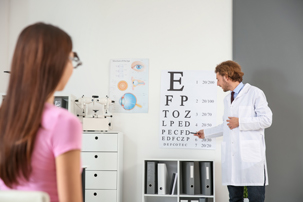
A vision defect or amblyopia — why do we see unclearly? |
| 17.12.2020 |
 The term “vision defect” is usually understood as a refractive error – short-sightedness, far-sightedness and astigmatism. A refractive error is the eye’s inability to properly focus the image on the central part of the retina without accommodation. In order to correct such an error and obtain an appropriate image corrective glasses or contact lenses are used. However, laser vision correction gives similar or better results. During a preliminary qualifying examination conducted before the surgery the patient may be diagnosed with amblyopia despite optimal correction with trial corrective lenses. It turns out that some of the patients are unaware of their amblyopia and its degree of severity, while others who know they have this condition, suffer from blurry vision and do not obtain satisfactory correction results with glasses – hope to have amblyopia corrected with laser instead. In case of amblyopia, poorer visual acuity is not caused by an optic system disorder, i.e. a vision defect, but by completely different factors.
The term “vision defect” is usually understood as a refractive error – short-sightedness, far-sightedness and astigmatism. A refractive error is the eye’s inability to properly focus the image on the central part of the retina without accommodation. In order to correct such an error and obtain an appropriate image corrective glasses or contact lenses are used. However, laser vision correction gives similar or better results. During a preliminary qualifying examination conducted before the surgery the patient may be diagnosed with amblyopia despite optimal correction with trial corrective lenses. It turns out that some of the patients are unaware of their amblyopia and its degree of severity, while others who know they have this condition, suffer from blurry vision and do not obtain satisfactory correction results with glasses – hope to have amblyopia corrected with laser instead. In case of amblyopia, poorer visual acuity is not caused by an optic system disorder, i.e. a vision defect, but by completely different factors.
Amblyopia, a so-called “lazy eye”, is a vision disorder in which the brain does not process impulses from the eye, which results in blurry vision. Amblyopia is a totally different condition from a vision defect. It involves a significant reduction in visual acuity despite the lack of any causes thereof related to the optic system, which are typical of refractive errors. This is why amblyopia cannot be corrected with glasses, contact lenses or laser.
Any condition which hinders the development of binocular visual acuity in childhood may lead to amblyopia. Amblyopia is difficult to diagnose, an ophthalmologic examination is hence recommended in children at the age of 4-5.
Reasons for the development of amblyopia:
Anisometropia – during the development period one eye worked for both due to a considerable difference in visual acuity (2-3D). The child’s brain „has learnt” to receive impulses solely from the eye with better visual acuity, whereas the other eye remains “the lazy one”.
Unilateral strabismus – a disorder caused by the wrong eye position. An image is created in a more peripheral area of the eye, which is why it is less sharp. If such an image will be preserved in the brain, the eye will develop amblyopia.
Limited use of one eye – in this case amblyopia occurs when proper functioning of the eye is disturbed as a result of a droopy eyelid, congenital cataract or wearing a dressing on one eye for a longer period of time.
High-degree refractive error, mainly far-sightedness and astigmatism – a significant, uncorrected refractive error in childhood may contribute to amblyopia. In this case the image on the retina is of very poor quality, which results in bilateral amblyopia.
Amblyopia is one of the most common causes of visual acuity impairment in one or both eyes. According to statistical data, approximately 2% of general population has amblyopia. A distinction is made between the following degrees of amblyopia: high (above 0,1), moderate (0,1-0,3) and low (0,3-0,8).
Treatment of amblyopia makes sense only within the child’s development period – up to the age of 10. The younger the child is and the lower the degree of amblyopia is the faster improvement progress is achieved. If the treatment is implemented too late, usually no significant progress is achieved and visual acuity remains reduced. The treatment consists of eliminating the causes of amblyopia.
Some of the patients who visit our clinic have amblyopia and would like to have it corrected with laser. During a qualifying examination an ophthalmic surgeon assesses the degree of amblyopia and its cause, and explains what correction result will be achieved after the surgery. If the patient still wants to undergo laser vision correction, then the procedure can be conducted. However, a patient may be disqualified from the surgery due to the severity of their amblyopia, as the post-surgical vision improvement would be insignificant in their case. Ineligibility for the procedure may also be a result of a situation when one eye is nearly blind and lens correction does not prove effective. In such case laser correction of a vision defect in the other eye is also impossible, for any risk of intervention has to be ruled out.
Regardless of the cause of your vision deterioration, we encourage you to make an appointment for an ophthalmologic examination in our Centre. An ophthalmologist will establish a precise diagnosis and check how we can help you. The appointment can be made via phone or a form available unde the CONTACT tab. If you have any questions, submit them through the ASK A DOCTOR tab.